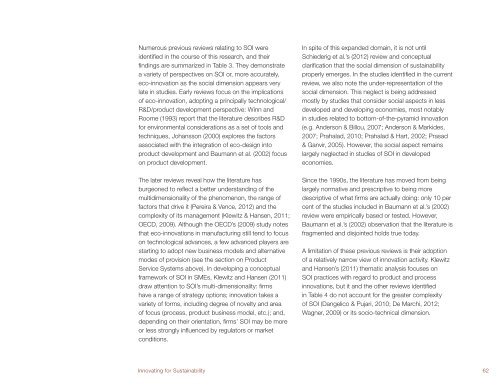Systematic Review - Network for Business Sustainability
Systematic Review - Network for Business Sustainability
Systematic Review - Network for Business Sustainability
Create successful ePaper yourself
Turn your PDF publications into a flip-book with our unique Google optimized e-Paper software.
Numerous previous reviews relating to SOI were<br />
identified in the course of this research, and their<br />
findings are summarized in Table 3. They demonstrate<br />
a variety of perspectives on SOI or, more accurately,<br />
eco-innovation as the social dimension appears very<br />
late in studies. Early reviews focus on the implications<br />
of eco-innovation, adopting a principally technological/<br />
R&D/product development perspective: Winn and<br />
Roome (1993) report that the literature describes R&D<br />
<strong>for</strong> environmental considerations as a set of tools and<br />
techniques, Johansson (2000) explores the factors<br />
associated with the integration of eco-design into<br />
product development and Baumann et al. (2002) focus<br />
on product development.<br />
The later reviews reveal how the literature has<br />
burgeoned to reflect a better understanding of the<br />
multidimensionality of the phenomenon, the range of<br />
factors that drive it (Pereira & Vence, 2012) and the<br />
complexity of its management (Klewitz & Hansen, 2011;<br />
OECD, 2009). Although the OECD’s (2009) study notes<br />
that eco-innovations in manufacturing still tend to focus<br />
on technological advances, a few advanced players are<br />
starting to adopt new business models and alternative<br />
modes of provision (see the section on Product<br />
Service Systems above). In developing a conceptual<br />
framework of SOI in SMEs, Klewitz and Hansen (2011)<br />
draw attention to SOI’s multi-dimensionality: firms<br />
have a range of strategy options; innovation takes a<br />
variety of <strong>for</strong>ms, including degree of novelty and area<br />
of focus (process, product business model, etc.); and,<br />
depending on their orientation, firms’ SOI may be more<br />
or less strongly influenced by regulators or market<br />
conditions.<br />
In spite of this expanded domain, it is not until<br />
Schiederig et al.’s (2012) review and conceptual<br />
clarification that the social dimension of sustainability<br />
properly emerges. In the studies identified in the current<br />
review, we also note the under-representation of the<br />
social dimension. This neglect is being addressed<br />
mostly by studies that consider social aspects in less<br />
developed and developing economies, most notably<br />
in studies related to bottom-of-the-pyramid innovation<br />
(e.g. Anderson & Billou, 2007; Anderson & Markides,<br />
2007; Prahalad, 2010; Prahalad & Hart, 2002; Prasad<br />
& Ganvir, 2005). However, the social aspect remains<br />
largely neglected in studies of SOI in developed<br />
economies.<br />
Since the 1990s, the literature has moved from being<br />
largely normative and prescriptive to being more<br />
descriptive of what firms are actually doing: only 10 per<br />
cent of the studies included in Baumann et al.’s (2002)<br />
review were empirically based or tested. However,<br />
Baumann et al.’s (2002) observation that the literature is<br />
fragmented and disjointed holds true today.<br />
A limitation of these previous reviews is their adoption<br />
of a relatively narrow view of innovation activity. Klewitz<br />
and Hansen’s (2011) thematic analysis focuses on<br />
SOI practices with regard to product and process<br />
innovations, but it and the other reviews identified<br />
in Table 4 do not account <strong>for</strong> the greater complexity<br />
of SOI (Dangelico & Pujari, 2010; De Marchi, 2012;<br />
Wagner, 2009) or its socio-technical dimension.<br />
Innovating <strong>for</strong> <strong>Sustainability</strong> 62
















